This species has been observed on Reunion, Mauritius, Mayotte, Madagascar and Seychelles Islands
This Gymnodoris is translucent
white, cream, yellow
to orange with small
orange-yellow
spots all over.
Each spot is raised on a short pointed papilla |

|
|
| Showing species characteristics... | Photo Philibert Bidgrain Reunion, Etang salé on the rocky coast, less 1 m, 1 February 2007, size : 18-20 mm |
|
See more about : Sightening and mating periods
See more about : Gymnodoris citrina variability in Southwest Indian ocean
Remarks :
Identification confirmed by Nathalie Yonow
According N. Yonow "These and all other creamy gymnodorids with little yellow spiky papillae, especially around the head and in a V-shape after the gills, a ring of creamy gills in the Indo-Pacific are all Gymnodoris citrina (Bergh, 1875). Often it is cited as 1877 but the illustration was published in 1875 and then the text in 1877.
Other authors considered that there are more than one species, so they separated : G. alba, G. bicolor, G. citrina.
Synonymous : (according Worms)
- Trevelyana citrina Bergh, 1877
Bibliographic data :
Some specimens are much more heavily pigmented with orange, with large orange spots, the head almost completely orange and the gills and rhinophores club translucent orange.
In some specimens two rows of orange-yellow pointed papilla form a slightly asymmetrical V-shaped pattern on either side of the branchiae.
The front of the mantle is broadly rounded and bears pointed orange-yellow tubercules. When animals are active, these pustules elongate so as to ressemble papillae
The rhinophores are large and lamellate and situated very closed together on top of the head. They have a translucent stalk and lower half of the clavus. The upper half of the clavus is uniformly brown or straw coloured or tending to olive green. Sometimes the club is tipped with orange. They have 15 vertical lamellae, and a swollen club at the distal end
The gills which are large and branched form a circle or nearly complete circle around the anus. They are translucent white or straw, cream to yellow coloured. Sometimes there is an orange line on the outer edge of each gills axis
The black digestive gland becomes clearly visible at the center after the animal has fed.
The genital aperture is situated on the right side half way between the rhinophores and the gills
Anterior end of the foot ends in two lobe sensory folds
It's a voracious predator of other Gymnodoris spp and is also cannibalistic
Found on shallow intertidal benches to 10m depth
References :
Bill Rudman Seaslug site : Sea Slug Forum : Gymnodoris citrina and G.alba
Nudipixel Gymnodoris citrina, G. alba and G. bicolor
Publications :
Bergh, L.S.R. (1875). Malacologische Untersuchungen. In: C.G. Semper, Reisen im Archipel der Philippinen, Wissenschaftliche Resultate. Band 2, Heft 8 : 315-344, Pls. 40-45
Gosliner, T.M. & Behrens, D.W. (1997) Description of four new species of phanerobranch dorids (Mollusca: Nudibranchia) from the Indo-Pacific, with a redescription of Gymnodoris aurita (Gould, 1852). Proceedings of the California Academy of Sciences, 49(9): 287-308
Yonow, N. (1984). Doridacean Nudibranchs from Sri Lanka, with descriptions of four new species. The Veliger. 26(3) : 214-228
Other photos of Gymnodoris citrina :
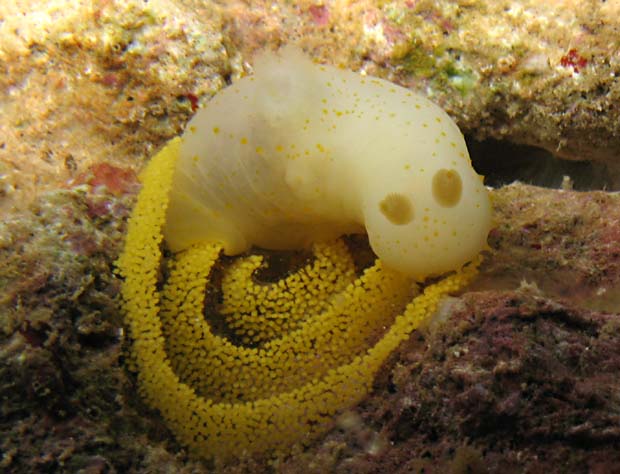 |
Philibert Bidgrain Réunion, Saint Gilles, less 1m, 19 October 2010, size : 15 mm With its egg masses ??? We need other observations to confirm... The shape of the spawn is different than Gymnodoris okinawae spawn 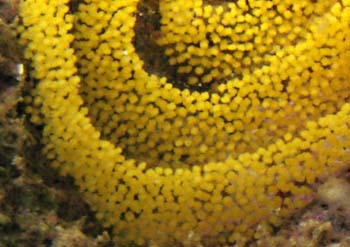 |
Sonia Ribes Beaudemoulin Reunion, Trou d’eau lagoon, Saint Gilles, less 1 m, under a rock, 22 March 2008, size : 18-20 mm. 3 specimens found during the same day... (a) The rhinophores have a translucent stalk and lower half of the clavus. The upper half of the clavus is uniformly brown to straw. They have 15 vertical lamellae, and a swollen club at the distal end (b) The front of the mantle is broadly rounded and bears pointed orange-yellow tubercules. When animals are active, these pustules elongate so as to ressemble papillae |
..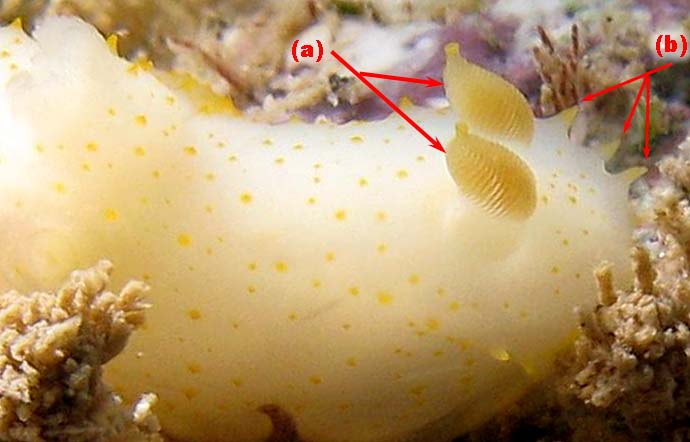 |
.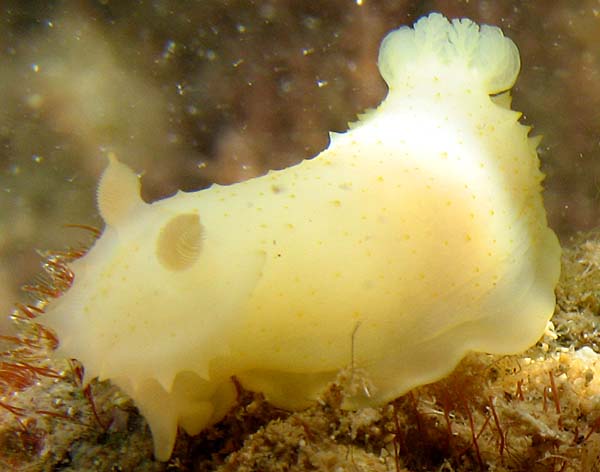 |
Philibert Bidgrain Mayotte, mtsanga Mboueanatsa, on the reef flat zone, less 1m, 5 August 2008, size : 30 mm The gills which are large and branched. They are translucent white or straw, cream to yellow coloured. The front of the mantle is broadly rounded and bears pointed orange-yellow tubercules. When animals are active, these pustules elongate so as to ressemble papillae 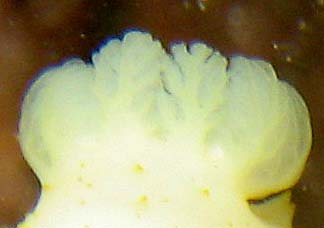 |
Philibert Bidgrain Mayotte, mtsanga Mboueanatsa, on the reef flat zone, less 1m, 13 October 2008, size : 20 mm The genital aperture is situated on the right side half way between the rhinophores and the gills. On this photo you can see the genital paplla between the rhinophores and the gills. |
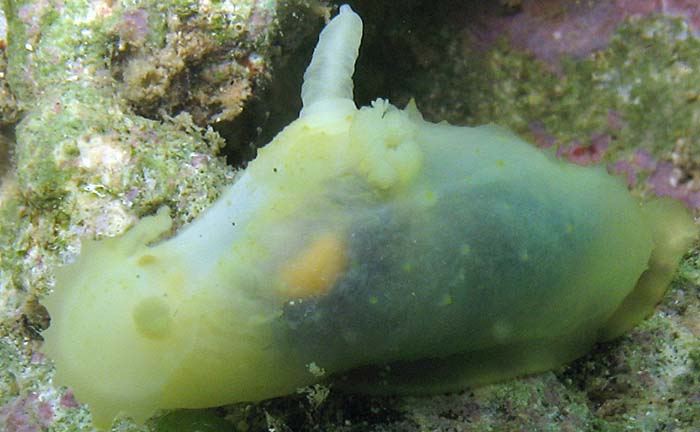 |
 |
Sonia Ribes Beaudemoulin Reunion, Trou d’eau lagoon, Saint Gilles, less 1 m, under a rock, 22 March 2008, size : 18-20 mm. In some specimens two rows of orange-yellow pointed papilla form a slightly asymmetrical V-shaped pattern on either side of the branchiae. |
Alain Barrére Reunion, "Le cimetière", Saint Leu lagoon, less 1m, 10 November 2004, size : 10-15 mm This Gymnodoris is translucent white with small orange-yellow spots all over. Each spot is raised on a short pointed papilla |
 |
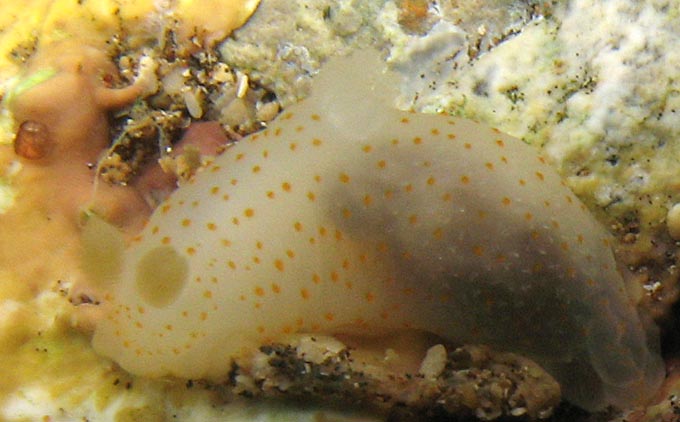 |
Eva Fontaine Mayotte, mtsanga jimaweni, on the reef flat zone, less 1m, 23 October 2008, size : 15 mm
|
Sophie Darnis Reunion, "Zone saliba" at Saint Gilles, 30m, 1 September 2007, size : 30-35 mm This Gymnodoris is translucent white, cream, yellow to orange with small orange-yellow spots all over Sometimes there is an orange line on the outer edge of each gills axis 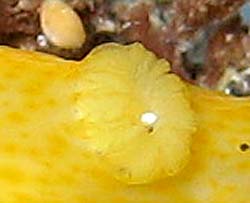 |
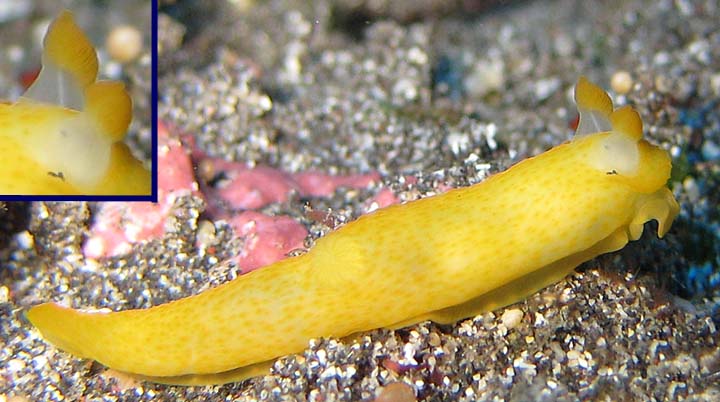 |
Christophe Cadet Reunion, Etang salé, on the rocky coast, less 1 m, 2 October 2009, size : 20 mm, This Gymnodoris is translucent white, cream,yellow to orange with small orange-yellow spots all over |  |
 |
Christophe Cadet Reunion, Etang salé, on the rocky coast, less 1 m, 4 October 2009 In this specimen the posterior end of the foot is tipped with orange (a) |
Alain-Benoît Rassat Madagascar, Patate Sud, Nosy Bé, 5 m, 15 April 2016, size : 40 mm
|
 |
| More photos from Indian Ocean |
See more about : Gymnodoris citrina variability in Southwest Indian ocean
See more about : Gymnodoris citrina excretion
Reunion, pale orange form of Gymnodoris citrina, at Etang salé, by Philibert Bidgrain
Reunion, head details of Gymnodoris citrina, at Etang salé, by Philibert Bidgrain
Reunion, orange juvenile of Gymnodoris citrina, at Saint Gilles, by Eva Fontaine
Reunion, small orange form of Gymnodoris citrina, at Etang salé, by Philibert Bidgrain
Reunion, two Gymnodoris citrina, at Saint Leu, by Eva Fontaine
Reunion, Gymnodoris citrina with its spawn, at Trou d'eau, by Philibert Bidgrain
Reunion, Gymnodoris citrina mating failed, at Etang salé, by Christophe Cadet
Mauritius, Gymnodoris citrina, at Ilot Sancho, by Philibert Bidgrain
Reunion, head detail of Gymnodoris citrina, at saint Gilles, by Philippe Bourjon
Seychelles, a yellow/orange Gymnodoris citrina, at Mahé, by Christophe Mason-Parker